Lithium-Ion Battery Online Rapid State-of-Power Estimation under Multiple Constraints
Abstract
:1. Introduction
2. Online Parameter and State Estimation
2.1. Battery Model
2.2. DEKF-Based Parameter and SOC Estimation
2.2.1. Online Parameter and State Estimation Based on DEKF
2.2.2. Online SOC Estimation Based on DEKF
3. State-of-Power Estimation
3.1. Peak State
3.2. Rapid-Calculating Peak Power/SOP Method
3.2.1. Traditional Peak Power/SOP Method
3.2.2. Rapid-Calculating Peak Power/SOP Method
3.3. Single Constraint
3.3.1. Designed Power Constraint
3.3.2. Current Constraint
3.3.3. SOC Constraint
3.3.4. Voltage Constraint
3.4. Multiple Constraints
3.4.1. Current and Voltage Dual-Constraint
3.4.2. Multiple Constraints of Current, Voltage, SOC, and Power
3.5. SOP Calculation
4. Experimental Design
4.1. Test Bench and Experiment Object
4.2. Experimental Procedure
5. Verification and Discussion
5.1. Verification for Battery Model
5.2. Verification for the DEKF-Based OCV Estimation
5.3. Verification for the SOC Estimation
5.4. Verification of the Peak Power and SOP Estimation
5.5. Verification of the Rapid-Calculating Method
6. Conclusions
- (1).
- The improved first-order RC model with one-state hysteresis and with parameters estimated online by DEKF has a high accuracy of 0.037 V in RMSE, which confirms the accuracy of the battery model to estimate SOC and peak power/SOP.
- (2).
- The DEKF-based OCV estimation has an RMSE of 0.0218 V and using the OCV estimated as the observed value, the SOC based on DEKF has a smaller RMSE of 0.28% than the one of 1.98% based on the OCV-SOC look-up method.
- (3).
- The peak power/SOP estimated under multiple constraints has the maximum relative error 6%/4%. The proposed rapid-calculating peak power method in Section 3.2 that calculates peak power during seconds through one or two instantaneous peak power is proven to be more effective.
Acknowledgments
Author Contributions
Conflicts of Interest
Nomenclature
| Symbols | |
| Simulink time, s | |
| prediction time horizon of peak power, s | |
| sampling time, s | |
| load current, A | |
| terminal voltage, V | |
| open-circuit voltage, V | |
| hysteresis voltage, V | |
| voltage across , V | |
| ohmic resistance, Ω | |
| charge ohmic resistance, Ω | |
| discharge ohmic resistance, Ω | |
| diffusion capacitance, F | |
| diffusion resistance, Ω | |
| maximum polarization due to hysteresis, V | |
| rate of decay | |
| sign function of | |
| battery nominal capacity, Ah | |
| coulombic efficiency | |
| time constant of a parallel resistance-capacitance circuit, s | |
| time of constant current (voltage) process, s | |
| total number of sampling points in | |
| peak power, W | |
| battery power design limit, W | |
| battery current design limit, A | |
| battery voltage design limit, V | |
| nominal power, W | |
| Subscripts, Superscripts | |
| time step index | |
| ch | charge |
| dis | discharge |
| max | upper limit value |
| min | lower limit value |
| - | estimation value |
| + | posteriori estimation value |
| Abbreviations | |
| BEV | battery electric vehicle |
| BMS | battery management system |
| CC | constant current |
| CV | constant voltage |
| DEKF | dual extended Kalman filtering |
| HEV | hybrid electric vehicle |
| HPPC | hybrid pulse power characterization |
| OCV | open-circuit voltage |
| PHEV | plug-in hybrid electric vehicle |
| PNGV | Partnership for New Generation Vehicle |
| RC | resistance-capacitance |
| RCM | rapid-calculating method |
| RMSE | root mean square error |
| SFUDS | Simplified version of the Federal Urban Driving Schedule |
| SOC | state of charge |
| SOH | state of health |
| SOP | state of power |
| TRM | traditional method |
References
- Chu, S.; Majumdar, A. Opportunities and challenges for a sustainable energy future. Nature 2012, 488, 294–303. [Google Scholar] [CrossRef] [PubMed]
- Un-Noor, F.; Padmanaban, S.; Mihet-Popa, L.; Mollah, M.N.; Hossain, E.; Sciubba, E. A Comprehensive Study of Key Electric Vehicle (EV) Components, Technologies, Challenges, Impacts, and Future Direction of Development. Energies 2017, 10, 1217. [Google Scholar] [CrossRef]
- Andwari, A.M.; Pesiridis, A.; Rajoo, S.; Martinez-Botas, R.; Esfahanian, V. A review of Battery Electric Vehicle technology and readiness levels. Renew. Sustain. Energy Rev. 2017, 78, 414–430. [Google Scholar] [CrossRef]
- Pollet, B.G.; Staffell, I.; Shang, J.L. Current status of hybrid, battery and fuel cell electric vehicles: From electrochemistry to market prospects. Electrochim. Acta 2012, 84, 235–249. [Google Scholar] [CrossRef]
- Hannan, M.A.; Azidin, F.A.; Mohamed, A. Hybrid electric vehicles and their challenges: A review. Renew. Sustain. Energy Rev. 2014, 29, 135–150. [Google Scholar] [CrossRef]
- Lu, L.; Han, X.; Li, J.; Hua, J.; Ouyang, M. A review on the key issues for lithium-ion battery management in electric vehicles. J. Power Sources 2013, 226, 272–288. [Google Scholar] [CrossRef]
- Rahimi-Eichi, H.; Ojha, U.; Baronti, F.; Chow, M. Battery Management System: An Overview of Its Application in the Smart Grid and Electric Vehicles. IEEE Ind. Electron. Mag. 2013, 7, 4–16. [Google Scholar] [CrossRef]
- Xing, Y.; Ma, E.W.M.; Tsui, K.L.; Pecht, M. Battery Management Systems in Electric and Hybrid Vehicles. Energies 2011, 4, 1840–1857. [Google Scholar] [CrossRef]
- Hannan, M.A.; Lipu, M.S.H.; Hussain, A.; Mohamed, A. A review of lithium-ion battery state of charge estimation and management system in electric vehicle applications: Challenges and recommendations. Renew. Sustain. Energy Rev. 2017, 78, 834–854. [Google Scholar] [CrossRef]
- Gao, Z.; Cheng, S.C.; Chiew, J.H.K.; Jia, J.; Zhang, C. Design and Implementation of a Smart Lithium-Ion Battery System with Real-Time Fault Diagnosis Capability for Electric Vehicles. Energies 2017, 10, 1503. [Google Scholar] [CrossRef]
- Chiew, J.; Chin, C.; Jia, J.; Toh, W. Thermal Analysis of a Latent Heat Storage based Battery Thermal Cooling Wrap. In Proceedings of the 2017 COMSOL Conference—Call for Papers and Posters, Singapore, 9 March 2017. [Google Scholar]
- Panchal, S.; Mathewson, S.; Fraser, R.; Culham, R.; Fowler, M. Thermal Management of Lithium-Ion Pouch Cell with Indirect Liquid Cooling using Dual Cold Plates Approach. SAE Int. J. Altern. Powertrains 2015, 4, 293–307. [Google Scholar] [CrossRef]
- Nejad, S.; Gladwin, D.T.; Stone, D.A. A systematic review of lumped-parameter equivalent circuit models for real-time estimation of lithium-ion battery states. J. Power Sources 2016, 316, 183–196. [Google Scholar] [CrossRef]
- Berecibar, M.; Gandiaga, I.; Villarreal, I.; Omar, N.; Mierlo, J.V.; Bossche, P.V.D. Critical review of state of health estimation methods of Li-ion batteries for real applications. Renew. Sustain. Energy Rev. 2016, 56, 572–587. [Google Scholar] [CrossRef]
- Waag, W.; Fleischer, C.; Sauer, D.U. Critical review of the methods for monitoring of lithium-ion batteries in electric and hybrid vehicles. J. Power Sources 2014, 258, 321–339. [Google Scholar] [CrossRef]
- Plett, G.L. Extended Kalman filtering for battery management systems of LiPB-based HEV battery packs: Part 3. State and parameter estimation. J. Power Sources 2004, 134, 277–292. [Google Scholar] [CrossRef]
- Plett, G.L. Extended Kalman filtering for battery management systems of LiPB-based HEV battery packs: Part 2. Modeling and identification. J. Power Sources 2004, 134, 262–276. [Google Scholar] [CrossRef]
- Plett, G.L. Extended Kalman filtering for battery management systems of LiPB-based HEV battery packs: Part 1. Background. J. Power Sources 2004, 134, 252–261. [Google Scholar] [CrossRef]
- Idaho National Engineering & Environmental Laboratory. Battery Test Manual for Plug-In Hybrid Electric Vehicles; Assistant Secretary for Energy Efficiency and Renewable Energy (EE) Idaho Operations Office: Idaho Falls, ID, USA, 2010.
- Plett, G.L. High-performance battery-pack power estimation using a dynamic cell model. IEEE Trans. Veh. Technol. 2004, 53, 1586–1593. [Google Scholar] [CrossRef]
- Moura, S.J.; Chaturvedi, N.A.; Krstić, M. Adaptive Partial Differential Equation Observer for Battery State-of-Charge/State-of-Health Estimation Via an Electrochemical Model. J. Dyn. Syst. Meas. Control 2014, 136, 011015. [Google Scholar] [CrossRef]
- Hu, X.; Tang, X. Review of Modeling Techniques for Lithium-ion Traction Batteries in Electric Vehicles. J. Mech. Eng. 2017, 53, 20–31. [Google Scholar] [CrossRef]
- Hu, X.; Li, S.; Peng, H. A comparative study of equivalent circuit models for Li-ion batteries. J. Power Sources 2012, 198, 359–367. [Google Scholar] [CrossRef]
- Seaman, A.; Dao, T.S.; Mcphee, J. A survey of mathematics-based equivalent-circuit and electrochemical battery models for hybrid and electric vehicle simulation. J. Power Sources 2014, 256, 410–423. [Google Scholar] [CrossRef]
- Liu, C.; Liu, W.; Wang, L.; Hu, G.; Ma, L.; Ren, B. A new method of modeling and state of charge estimation of the battery. J. Power Sources 2016, 320, 1–12. [Google Scholar] [CrossRef]
- Dey, S.; Ayalew, B.; Pisu, P. Nonlinear Adaptive Observer for a Lithium-Ion Battery Cell Based on Coupled Electrochemical-Thermal Model. J. Dyn. Syst. Meas. Control 2015, 137, 111005. [Google Scholar] [CrossRef]
- Lin, X.; Perez, H.E.; Mohan, S.; Siegel, J.B.; Stefanopoulou, A.G.; Ding, Y.; Castanier, M.P. A lumped-parameter electro-thermal model for cylindrical batteries. J. Power Sources 2014, 257, 1–11. [Google Scholar] [CrossRef]
- Fotouhi, A.; Auger, D.J.; Propp, K.; Longo, S.; Wild, M. A review on electric vehicle battery modelling: From Lithium-ion toward Lithium–Sulphur. Renew. Sustain. Energy Rev. 2016, 56, 1008–1021. [Google Scholar] [CrossRef]
- Gao, Z.; Chin, C.S.; Woo, W.L.; Jia, J. Integrated Equivalent Circuit and Thermal Model for Simulation of Temperature-Dependent LiFePO4 Battery in Actual Embedded Application. Energies 2017, 10, 85. [Google Scholar] [CrossRef]
- Wang, J.; Liu, P.; Hicks-Garner, J.; Sherman, E.; Soukiazian, S.; Verbrugge, M.; Tataria, H.; Musser, J.; Finamore, P. Cycle-life model for graphite-LiFePO4 cells. J. Power Sources 2011, 196, 3942–3948. [Google Scholar] [CrossRef]
- Panchal, S.; Mcgrory, J.; Kong, J.; Fraser, R.; Fowler, M.; Dincer, I.; Agelin-Chaab, M. Cycling degradation testing and analysis of a LiFePO4 battery at actual conditions. Int. J. Energy Res. 2017, 41, 2565–2575. [Google Scholar] [CrossRef]
- Sun, F.; Xiong, R.; He, H.; Li, W.; Aussems, J.E.E. Model-based dynamic multi-parameter method for peak power estimation of lithium–ion batteries. Appl. Energy 2012, 96, 378–386. [Google Scholar] [CrossRef]
- Xiong, R.; He, H.; Sun, F.; Liu, X.; Liu, Z. Model-based state of charge and peak power capability joint estimation of lithium-ion battery in plug-in hybrid electric vehicles. J. Power Sources 2013, 229, 159–169. [Google Scholar] [CrossRef]
- Xiong, R.; Sun, F.; He, H.; Nguyen, T.D. A data-driven adaptive state of charge and power capability joint estimator of lithium-ion polymer battery used in electric vehicles. Energy 2013, 63, 295–308. [Google Scholar] [CrossRef]
- Pei, L.; Zhu, C.; Wang, T.; Lu, R.; Chan, C.C. Online peak power prediction based on a parameter and state estimator for lithium-ion batteries in electric vehicles. Energy 2014, 66, 766–778. [Google Scholar] [CrossRef]
- Sun, F.; Xiong, R.; He, H. Estimation of state-of-charge and state-of-power capability of lithium-ion battery considering varying health conditions. J. Power Sources 2014, 259, 166–176. [Google Scholar] [CrossRef]
- Feng, T.; Yang, L.; Zhao, X.; Zhang, H.; Qiang, J. Online identification of lithium-ion battery parameters based on an improved equivalent-circuit model and its implementation on battery state-of-power prediction. J. Power Sources 2015, 281, 192–203. [Google Scholar] [CrossRef]
- Zhang, W.; Shi, W.; Ma, Z. Adaptive unscented Kalman filter based state of energy and power capability estimation approach for lithium-ion battery. J. Power Sources 2015, 289, 50–62. [Google Scholar] [CrossRef]
- Jiang, J.; Liu, S.; Ma, Z.; Wang, L.Y.; Wu, K. Butler-Volmer equation-based model and its implementation on state of power prediction of high-power lithium titanate batteries considering temperature effects. Energy 2016, 117, 58–72. [Google Scholar] [CrossRef]
- Haykin, S.; Puskorius, G.V.; Feldkamp, L.A.; Patel, G.S.; Becker, S.; Racine, R.; Wan, E.A.; Nelson, A.T.; Roweis, S.T.; Ghahramani, Z.; et al. Dual Extended Kalman Filter Methods. In Kalman Filtering and Neural Networks; John Wiley & Sons, Inc.: Hoboken, NJ, USA, 2001; pp. 123–173. [Google Scholar]
- Cuma, M.U.; Koroglu, T. A comprehensive review on estimation strategies used in hybrid and battery electric vehicles. Renew. Sustain. Energy Rev. 2015, 42, 517–531. [Google Scholar] [CrossRef]
- He, H.; Zhang, X.; Xiong, R.; Xu, Y.; Guo, H. Online model-based estimation of state-of-charge and open-circuit voltage of lithium-ion batteries in electric vehicles. Energy 2012, 39, 310–318. [Google Scholar] [CrossRef]
- Zhang, J.; Lee, J. A review on prognostics and health monitoring of Li-ion battery. J. Power Sources 2011, 196, 6007–6014. [Google Scholar] [CrossRef]
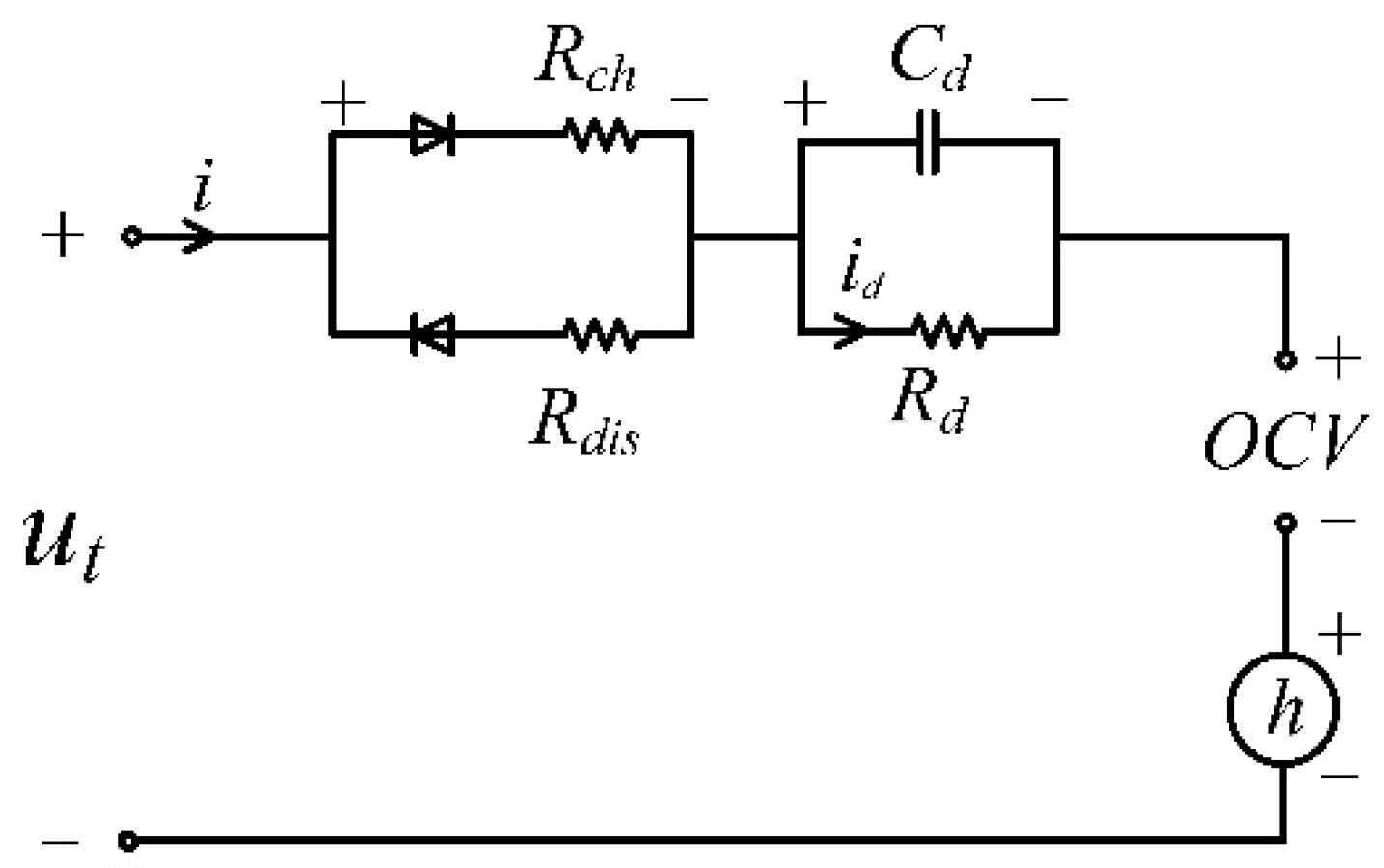
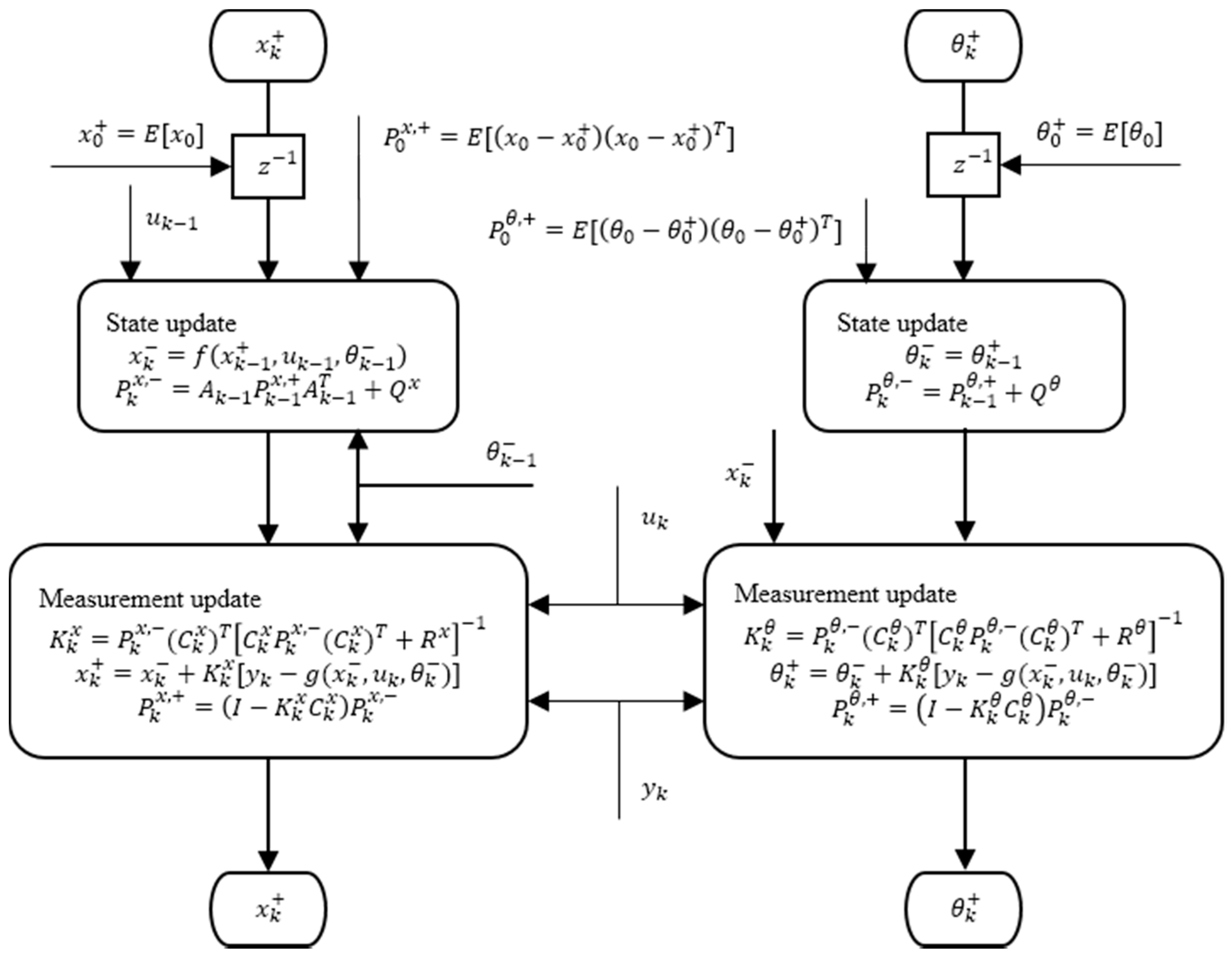
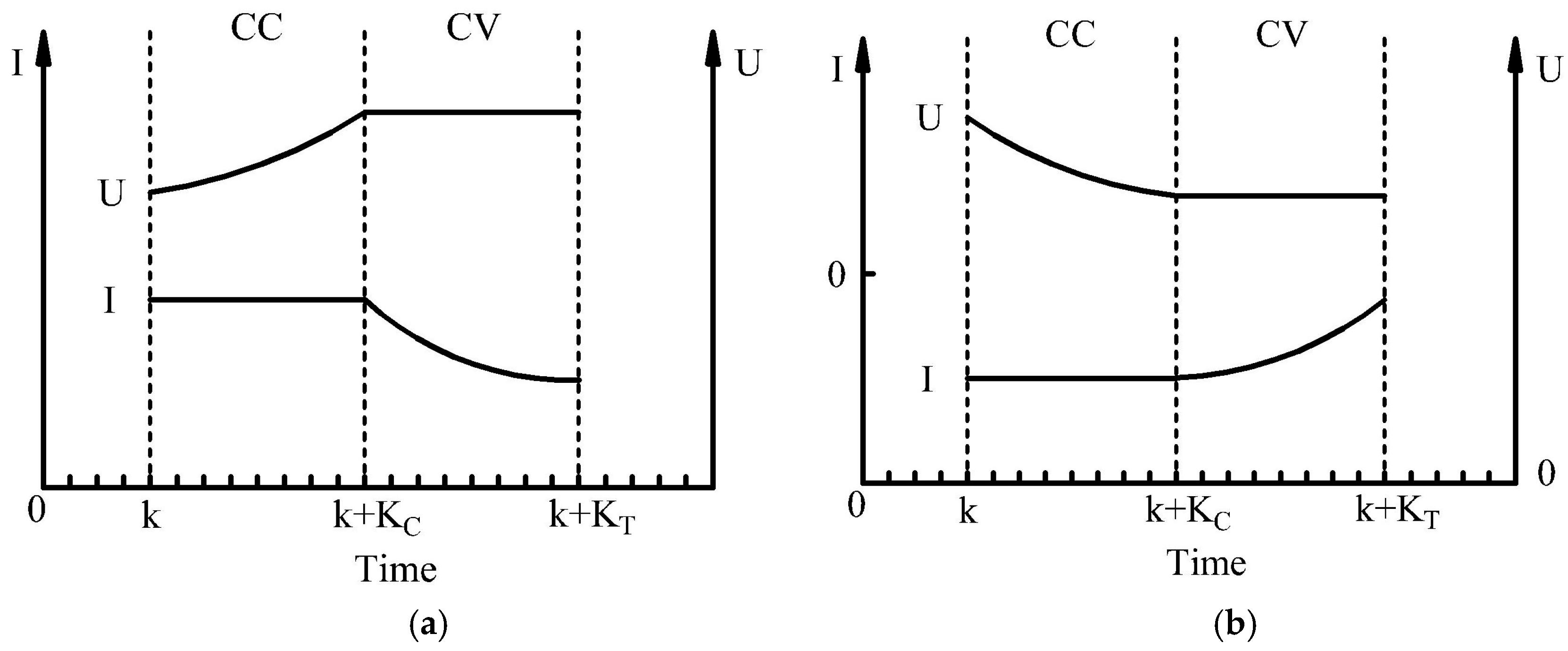
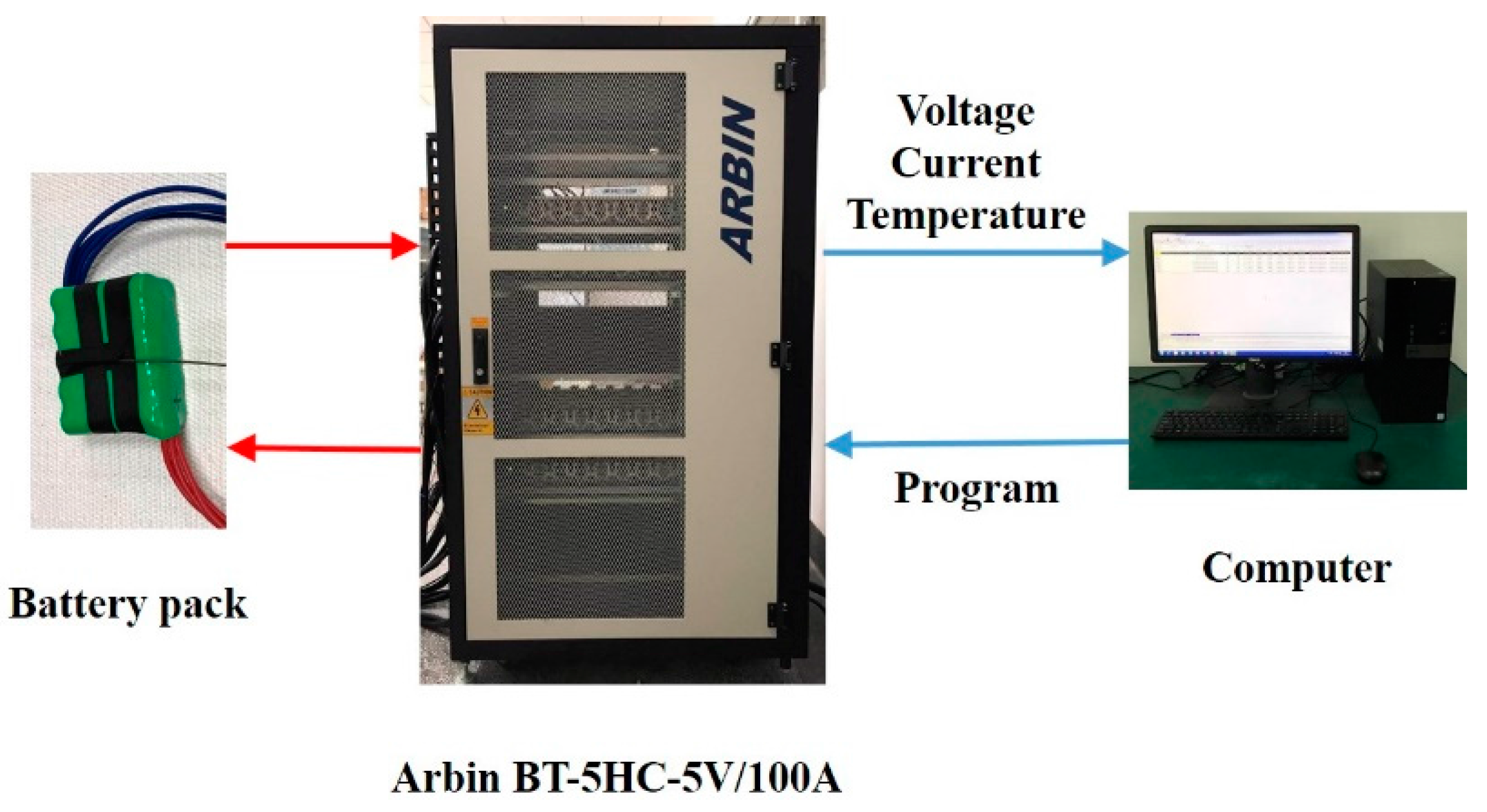

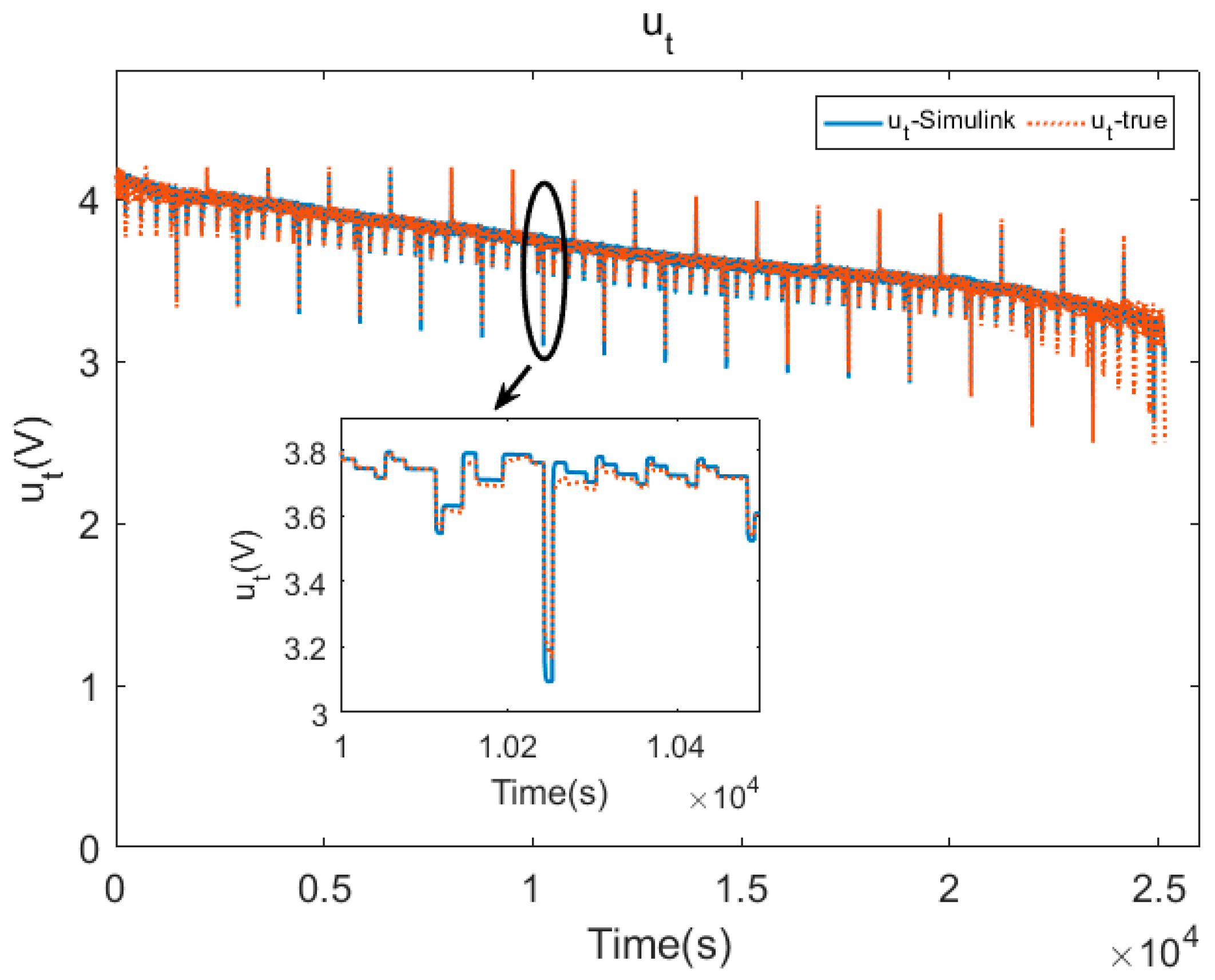
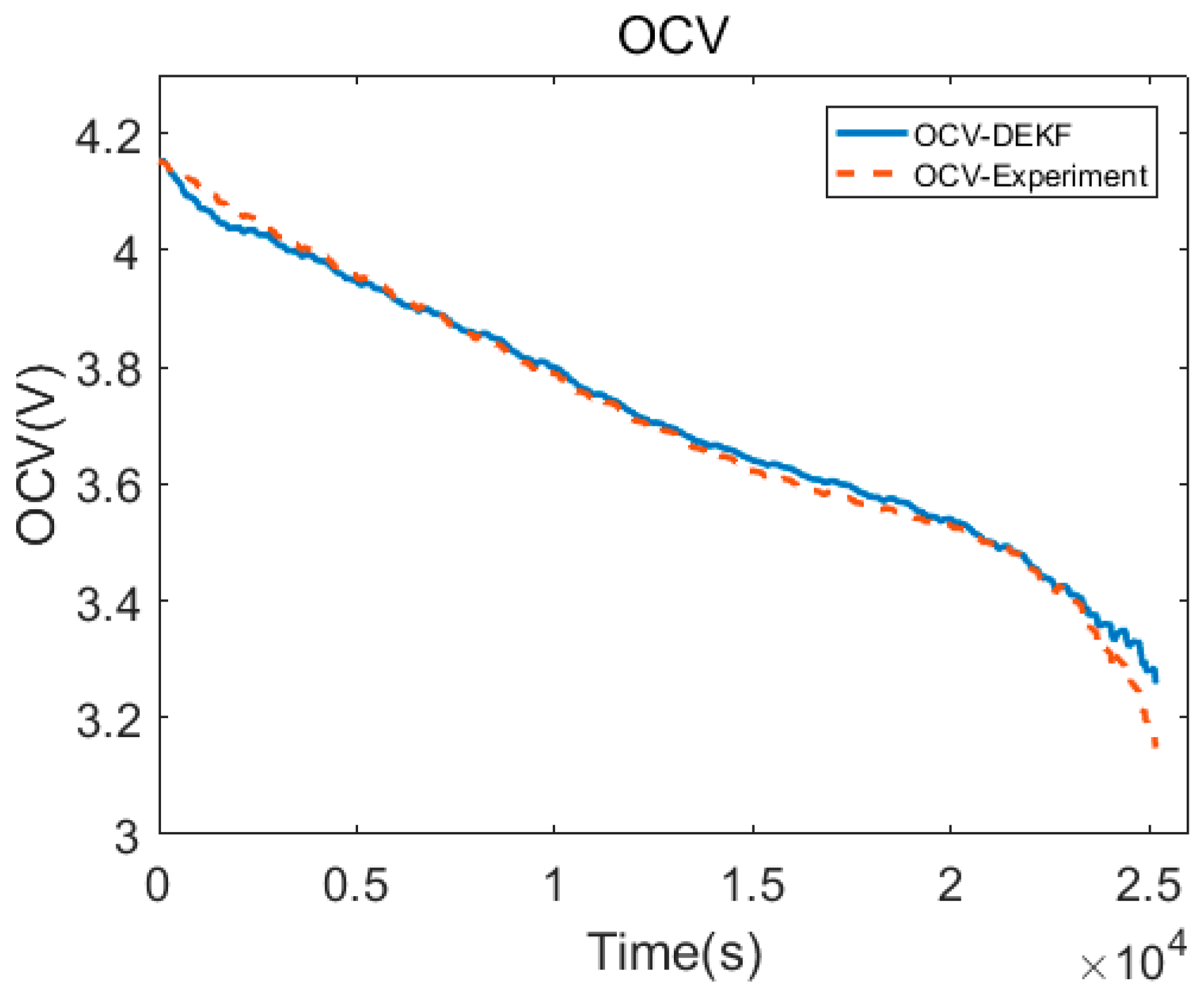
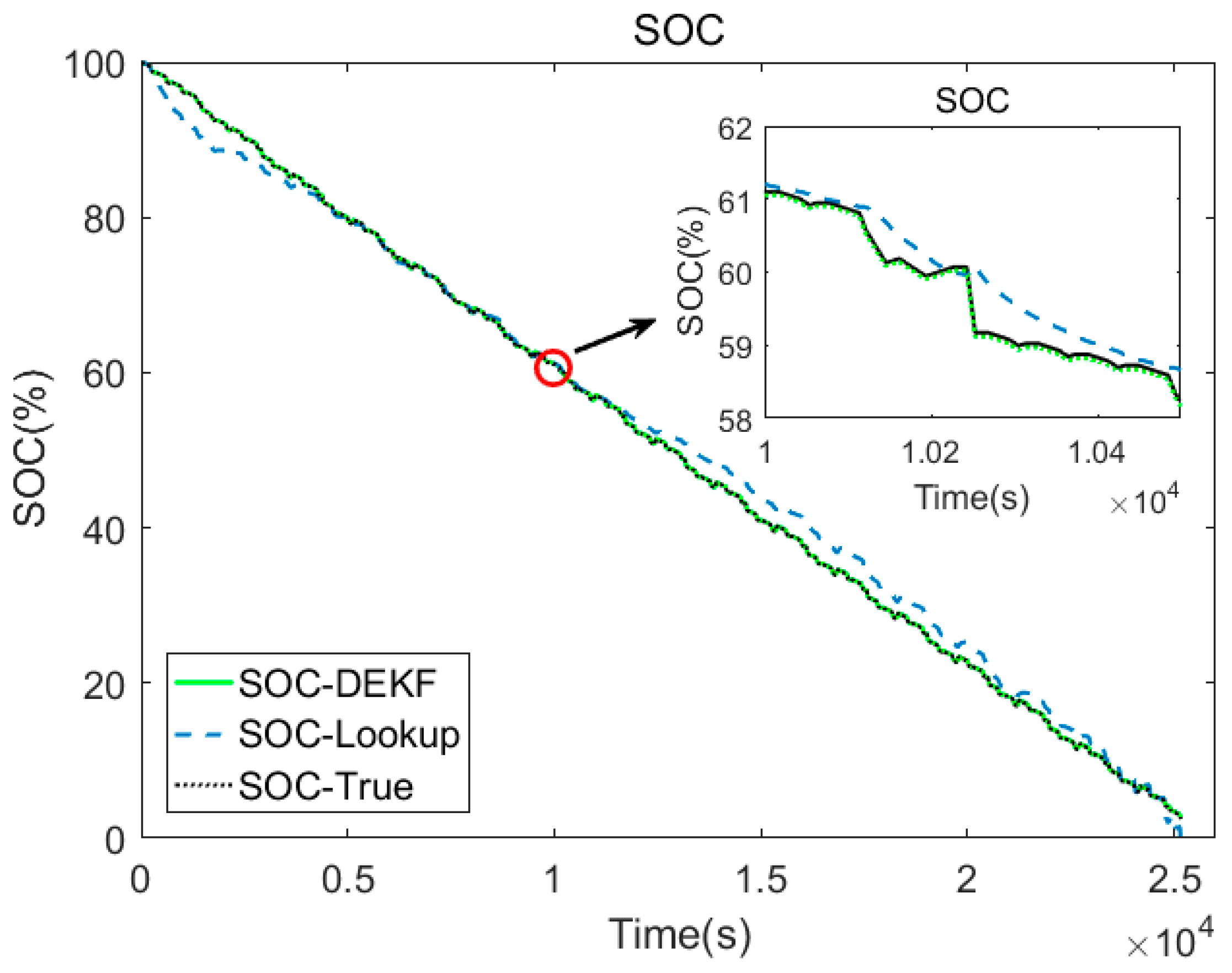
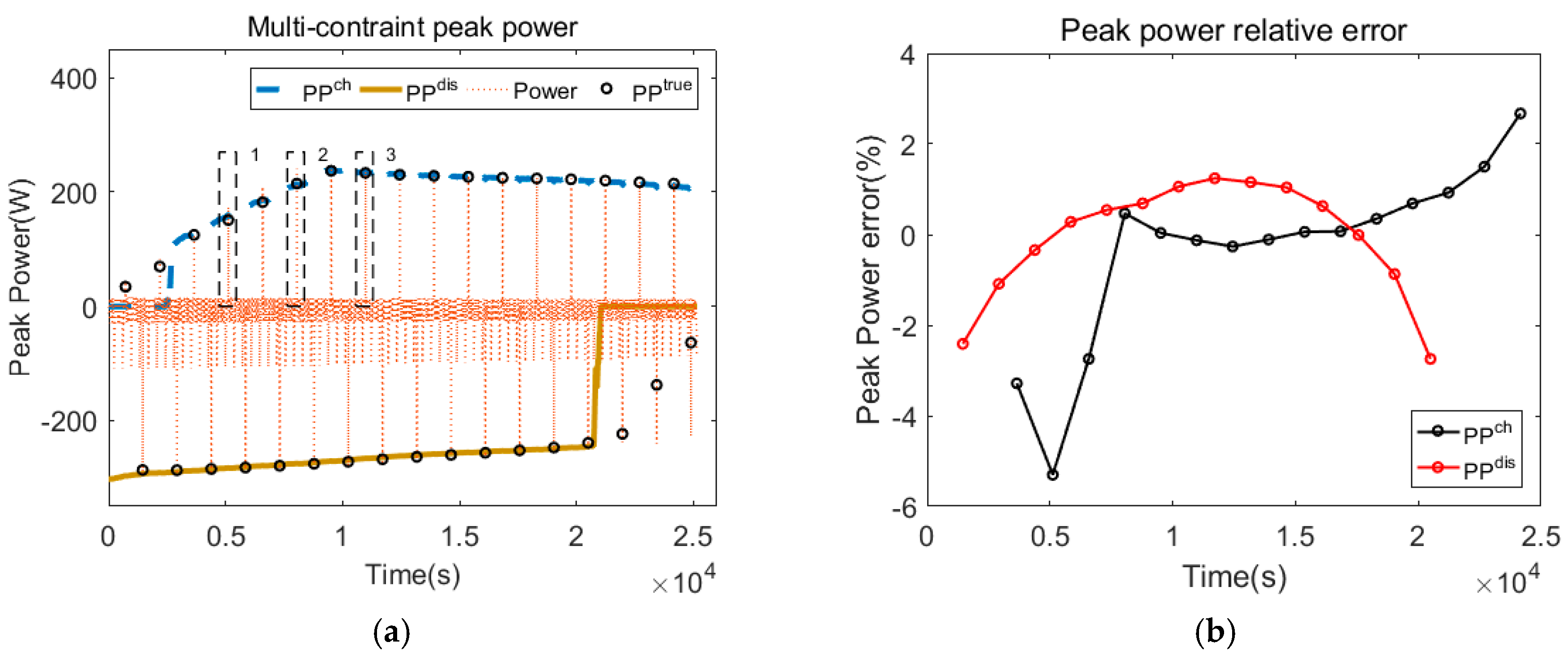
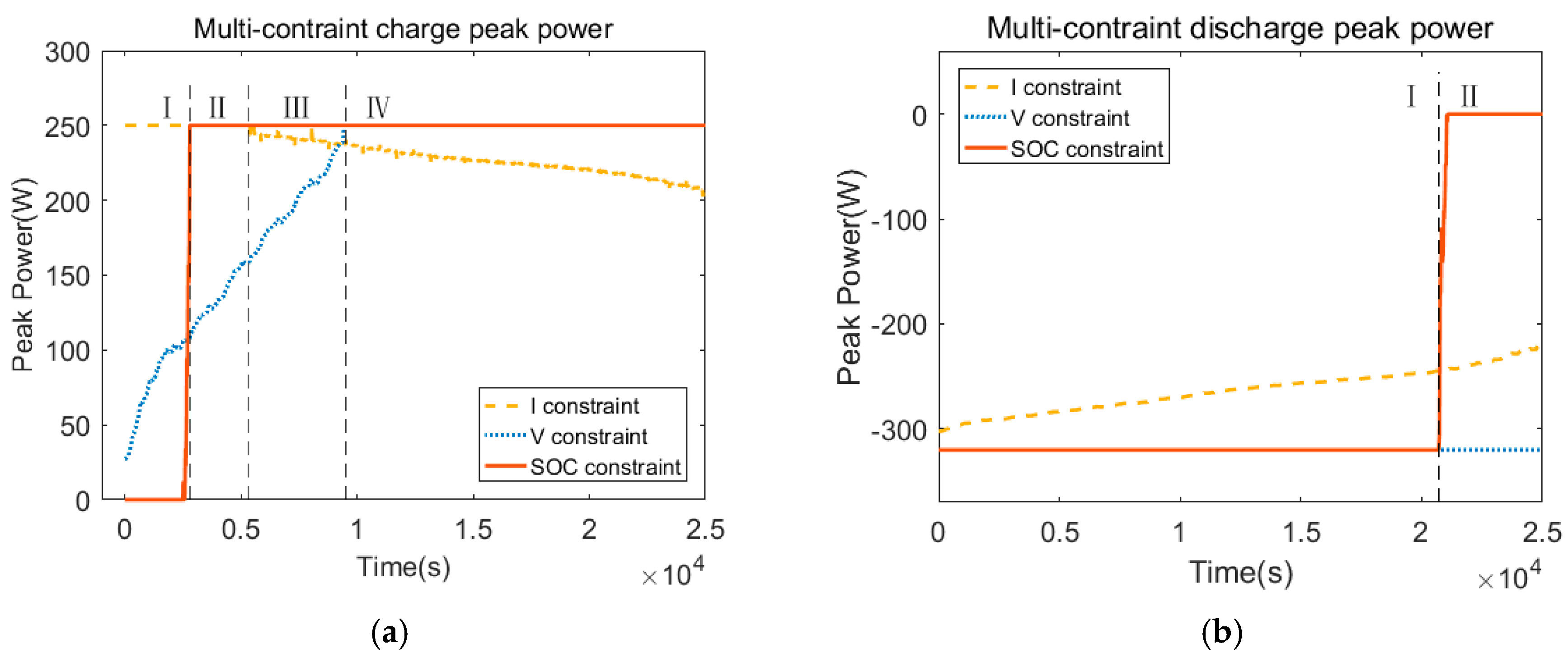

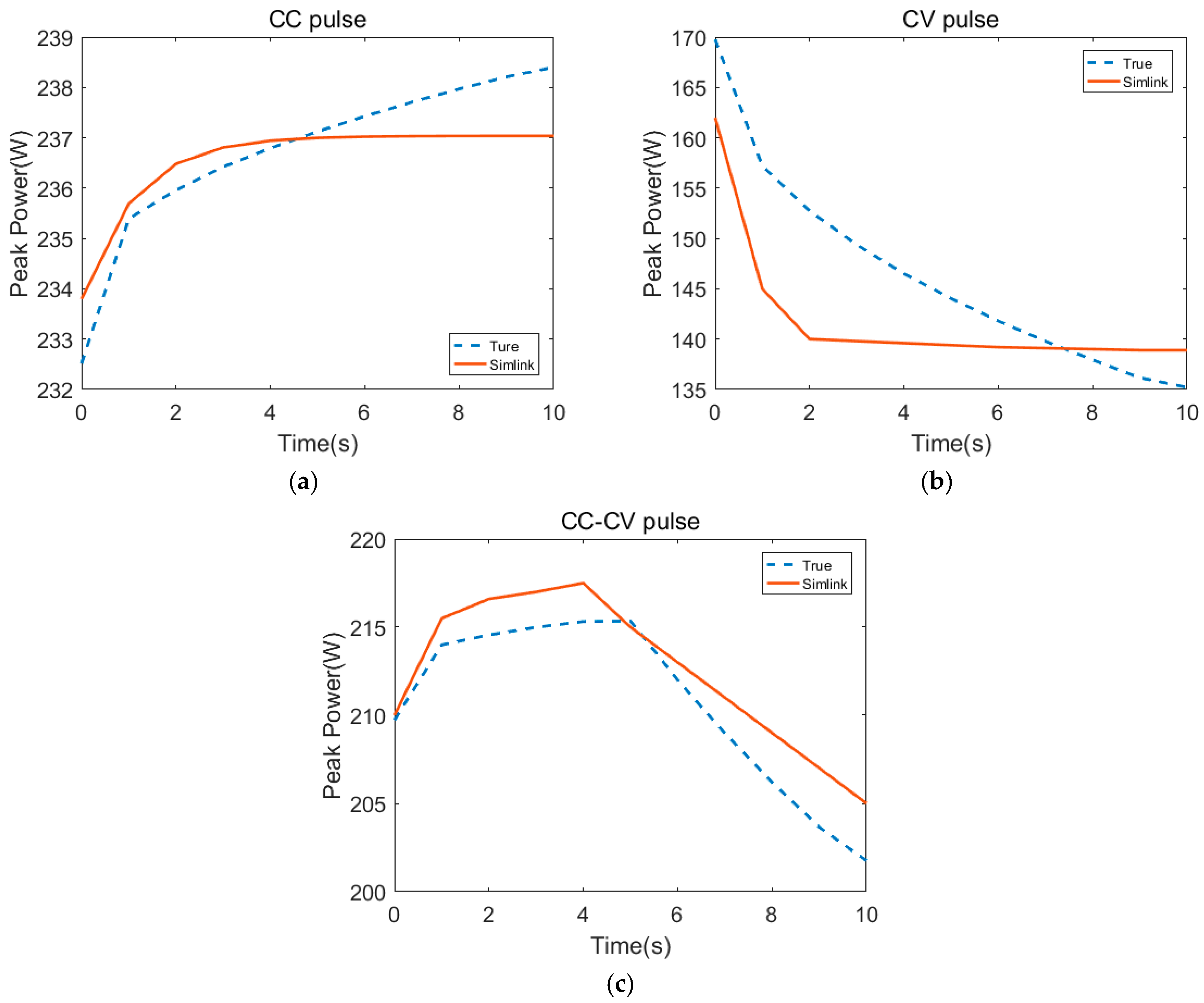
| Battery Parameters | Value |
|---|---|
| Anode material | MnO2 |
| Cathode material | Li |
| (Ah) | 26.6 |
| (A) | 53.2 |
| (A) | −79.8 |
| (V) | 4.2 |
| (V) | 2.5 |
| (W) | 250 |
| (W) | −320 |
| 0.2 | |
| 0.9 |
| PPch_RMSE (W) | PPdis_RMSE (W) | SOPch_RMSE (%) | SOPdis_RMSE (%) | Time (s) | tRCM/tTRM (%) | |
|---|---|---|---|---|---|---|
| Pulse_10s_RCM | 3.095 | 3.330 | 1.2 | 1.0 | 7.402 | 71.1 |
| Pulse_10s_TRM | 3.095 | 3.330 | 1.2 | 1.0 | 10.409 | / |
| Pulse_20s_RCM | 6.070 | 4.497 | 2.4 | 1.4 | 8.784 | 38.2 |
| Pulse_20s_TRM | 6.070 | 4.497 | 2.4 | 1.4 | 23.014 | / |
| Pulse_30s_RCM | 8.351 | 5.505 | 3.3 | 1.7 | 10.801 | 23.5 |
| Pulse_30s_TRM | 8.351 | 5.505 | 3.3 | 1.7 | 45.876 | / |
© 2018 by the authors. Licensee MDPI, Basel, Switzerland. This article is an open access article distributed under the terms and conditions of the Creative Commons Attribution (CC BY) license (http://creativecommons.org/licenses/by/4.0/).
Share and Cite
Xiang, S.; Hu, G.; Huang, R.; Guo, F.; Zhou, P. Lithium-Ion Battery Online Rapid State-of-Power Estimation under Multiple Constraints. Energies 2018, 11, 283. https://doi.org/10.3390/en11020283
Xiang S, Hu G, Huang R, Guo F, Zhou P. Lithium-Ion Battery Online Rapid State-of-Power Estimation under Multiple Constraints. Energies. 2018; 11(2):283. https://doi.org/10.3390/en11020283
Chicago/Turabian StyleXiang, Shun, Guangdi Hu, Ruisen Huang, Feng Guo, and Pengkai Zhou. 2018. "Lithium-Ion Battery Online Rapid State-of-Power Estimation under Multiple Constraints" Energies 11, no. 2: 283. https://doi.org/10.3390/en11020283
APA StyleXiang, S., Hu, G., Huang, R., Guo, F., & Zhou, P. (2018). Lithium-Ion Battery Online Rapid State-of-Power Estimation under Multiple Constraints. Energies, 11(2), 283. https://doi.org/10.3390/en11020283





